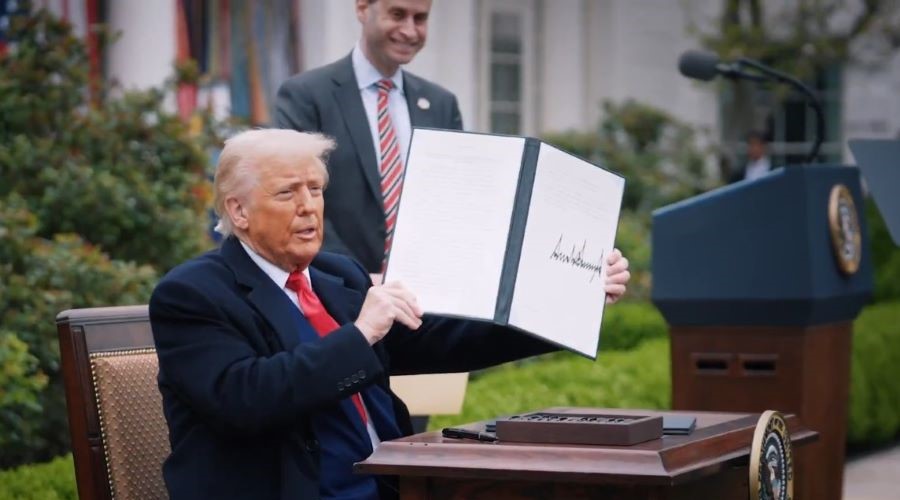The key date has arrived: Donald Trump has proclaimed his so-called “Liberation Day”, during which he introduced “reciprocal” import tariffs—though not entirely reciprocal—that significantly impact the automotive sector.
Beyond the debate on the methodology used by the US government to set tariff levels for each trading partner, the electric vehicle market has been left virtually paralysed amidst confusion and media headlines.
According to multiple analysts, these measures represent the most significant disruption to the global trade order since World War II. On Thursday, they caused stock markets around the world to tumble.
Understanding the New US Tariffs
Trump displayed a chart with two columns: one showing the alleged trade barriers countries impose on US goods—including indirect measures such as currency manipulation or health regulations—and the other listing the new tariffs the US will apply in response.
These new tariffs also take a toll on the global automotive sector.
The plan introduces a baseline tariff of 10% on all imported goods, with no exceptions by sector or category, effective Friday, 5 April.
From 9 April onwards, higher duties will apply to imports from over 60 countries that the White House deems most responsible for what Trump calls “decades of trade abuse.”
Among these:
- China (34%)
- European Union (20%)
- Japan (24%)
- South Korea (25%)
- India (26%)
- Vietnam (46%)
- Cambodia (49%)
China is a particularly notable case. Its electric vehicles have faced a 100% tariff since September 2024, imposed by former president Joe Biden.
According to experts and several international outlets, the new 34% tariff would not be added on top of the existing 100%. However, a new 25% duty on all foreign-made vehicles would apply. In other words, Chinese electric vehicles now face a 125% total import duty.
Impact on Mexico’s Automotive Industry
In Latin America, Mexico stands out as the only significant exporter of vehicles to the United States. As a member of the United States-Mexico-Canada Agreement (USMCA), it enjoys a tightly integrated supply chain with its two northern neighbours—particularly in auto parts.
The administration of Claudia Sheinbaum had been especially concerned about the much-discussed tariffs and their potential consequences for the Mexican economy.
Mexico’s position as the leading vehicle exporter to the US makes it a key player in this new trade landscape.
In 2024, Mexico exported more than 2.7 million vehicles to the US market—accounting for around 80% of its total vehicle exports.
Should the US government decide to implement additional tariffs based on foreign content or political motivations (such as fentanyl trafficking), Mexico’s automotive industry could be severely affected—threatening jobs, investments, and economic growth.
For now, however, Mexico and Canada are temporarily exempt. But a second phase of tariffs could target vehicles assembled in these countries based on the percentage of non-American content.
This includes components such as engines, electrical systems and transmissions, which are often sourced from Asia or Europe.
Global Impact: Japanese, European and US Carmakers Also Affected
The new tariffs are set to severely impact major car brands like Toyota, Honda, Hyundai, Kia, BMW and Volkswagen, all of which maintain a strong presence in the US market.
However, the collateral damage will also extend to US automakers such as General Motors, Ford, and Stellantis, whose supply chains and production facilities rely heavily on operations in Mexico and Canada.
Toyota, the sector leader, is expected to be heavily affected by the new tariff regime.
According to industry data, a significant proportion of vehicles sold in the US contain critical components manufactured outside North America, making them vulnerable under the new scheme.
“The industry is facing a rise in costs that could be passed directly on to consumers,” warned automotive associations quoted by the BBC, estimating that vehicle prices could increase by between $2,500 and $20,000 per unit, depending on the model and level of imported content.
The decree specifies that the new 25% duty will only apply to the percentage of a vehicle made up of non-American content.
However, the calculation mechanism has yet to be defined, creating uncertainty for manufacturers and exporters.
Moreover, it remains unclear whether the 25% tariff will be cumulative with other general tariffs that Trump has threatened to impose on Mexican and Canadian goods for immigration or security reasons.
If a double tariff were to be applied, the cost burden on vehicles from the USMCA bloc could double, severely affecting the region’s competitiveness.






